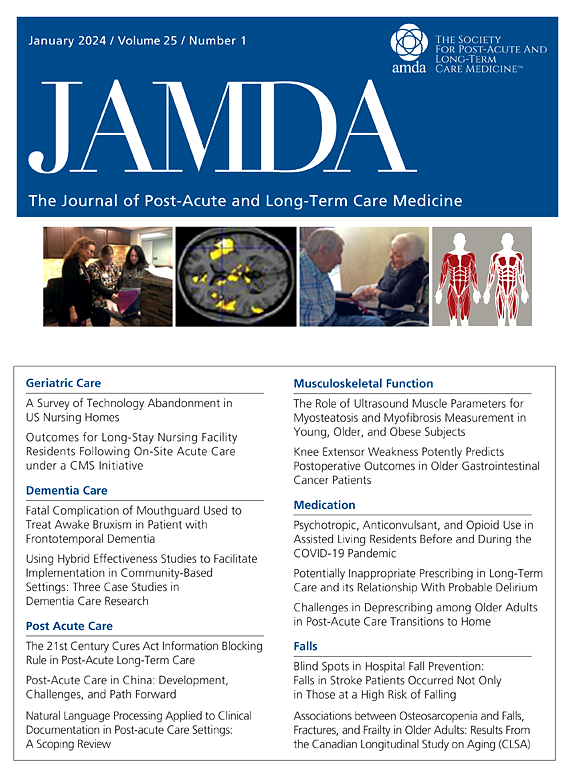Does the Veterans Health Administration Purchase High-Quality Home Health Care?
IF 4.2
2区 医学
Q2 GERIATRICS & GERONTOLOGY
Journal of the American Medical Directors Association
Pub Date : 2025-06-05
DOI:10.1016/j.jamda.2025.105684
引用次数: 0
Abstract
Objectives
Veterans are frequently referred for skilled home health care (HHC) after hospital discharge. We examined access to high-quality VA-contracted home health agencies (HHAs) for Veterans following a VA medical center (VAMC) hospitalization and by rural or urban residence.
Design
Retrospective observational study.
Setting and Participants
We used national VA data from April 2015 to September 2019 and included all Veterans discharged from a VAMC hospitalization who received skilled HHC paid for by VA.
Methods
We assigned every eligible discharge a choice set of VA-contracted HHAs serving the Veteran's county and a choice set of all HHAs serving the Veteran's county. We calculated a quality ratio (QR): the percentage of high-quality VA-contracted (4- or 5-star) HHAs relative to all high-quality HHAs serving the county reported in Home Health Compare. We then aggregated the QR by VAMC. High QRs (average QR and 95% CI >1) indicate VA contracts with higher-quality HHAs, relative to all HHAs serving the county. Neutral QRs (positive or negative average QR and 95% CI includes 1) indicate no difference in quality. Low QRs (average QR and 95% CI <1) indicate a lower-quality network. We examined bootstrapped QRs by VAMCs, including the subset serving mostly rural Veterans.
Results
We identified 60,406 VA-paid HHC episodes for 42,010 Veterans discharged from 113 VAMCs. Although 61.1% of VAMCs had high QRs, only 27.3% of the 33 VAMCs serving rural Veterans had high QRs. Rural-residing Veterans had lower proportions of high QRs than urban Veterans (46.3% vs 64.0%) and nearly double the proportion of neutral QRs (31.5% vs 16.2%), but similar proportions of low QRs (22.2% vs 19.1%).
Conclusions and Implications
Overall, VA-contracted HHAs were of higher quality compared to available HHAs serving Veterans’ counties. Although VAMCs serving mostly rural Veterans provided less access to higher-quality HHAs, this effect was driven by more access to neutral quality HHAs in rural counties, not by differentially contracting with lower-quality HHAs.
退伍军人健康管理局购买高质量的家庭医疗保健吗?
目的:退伍军人出院后经常被转介到熟练的家庭保健(HHC)。我们调查了在退伍军人医疗中心(VAMC)住院的退伍军人以及农村或城市居民获得高质量退伍军人签约家庭健康机构(HHAs)的情况。设计:回顾性观察性研究。环境和参与者:我们使用了2015年4月至2019年9月的全国VA数据,包括所有从VAMC住院出院的退伍军人,他们接受了VA支付的熟练HHC。方法:我们为每个符合条件的出院者分配了一组为退伍军人县服务的VA合同hha和一组为退伍军人县服务的所有hha。我们计算了质量比(QR):高质量va签约的(4星或5星)hha相对于家庭健康比较中报告的为该县服务的所有高质量hha的百分比。然后我们按VAMC汇总QR。高QR(平均QR和95% CI bbb1)表明,相对于为该县服务的所有hha, VA合同具有更高质量的hha。中性QR(阳性或阴性平均QR和95% CI包括1)表明质量没有差异。低QR(平均QR和95% CI)结果:在113个VAMCs出院的42,010名退伍军人中,我们确定了60,406例va支付的HHC发作。尽管61.1%的VAMCs具有高QRs,但在33个为农村退伍军人服务的VAMCs中,只有27.3%具有高QRs。农村退伍军人的高质量评分比例低于城市退伍军人(46.3%比64.0%),中性质量评分比例几乎是城市退伍军人的两倍(31.5%比16.2%),但低质量评分比例相似(22.2%比19.1%)。结论和意义:总体而言,与退伍军人县现有的hha相比,va承包的hha质量更高。尽管主要为农村退伍军人服务的VAMCs提供的高质量hha较少,但这种影响是由农村县获得多个hha的机会较少造成的,而不是由与低质量hha的差异承包造成的。
本文章由计算机程序翻译,如有差异,请以英文原文为准。
求助全文
约1分钟内获得全文
求助全文
来源期刊
CiteScore
11.10
自引率
6.60%
发文量
472
审稿时长
44 days
期刊介绍:
JAMDA, the official journal of AMDA - The Society for Post-Acute and Long-Term Care Medicine, is a leading peer-reviewed publication that offers practical information and research geared towards healthcare professionals in the post-acute and long-term care fields. It is also a valuable resource for policy-makers, organizational leaders, educators, and advocates.
The journal provides essential information for various healthcare professionals such as medical directors, attending physicians, nurses, consultant pharmacists, geriatric psychiatrists, nurse practitioners, physician assistants, physical and occupational therapists, social workers, and others involved in providing, overseeing, and promoting quality

 求助内容:
求助内容: 应助结果提醒方式:
应助结果提醒方式:


